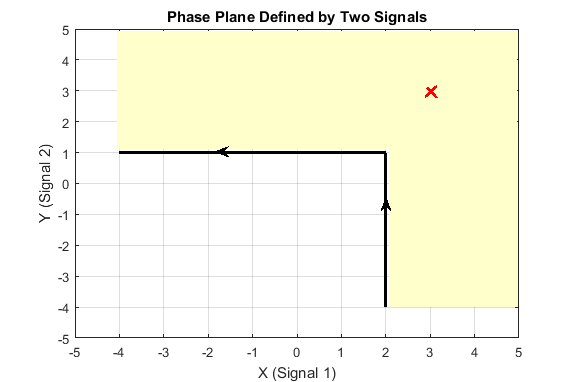sdo.requirements.PhasePlaneRegion Class
Namespace: sdo.requirements
Superclasses:
Impose region bound on phase plane trajectory of two signals
Description
Use the sdo.requirements.PhasePlaneRegion object
to impose a region bound on the phase plane trajectory of two signals
in a Simulink® model. The phase plane trajectory is a plot of
the two signals against each other. In the object, you can specify
the bounded region as a single edge, or multiple piecewise-linear
edges. You specify the starting and ending x and y coordinates
of the bound edges, where the X-Y plane is the phase plane defined
by the two signals. You also specify whether you require the trajectory
of the two signals to lie inside or outside the bounded region specified
by the edges.
You can use the object as an input to your cost function,
and use the evalRequirement command in the cost
function to evaluate whether your test signals satisfy the specified
requirement. You can then use the cost function and sdo.optimize to perform parameter estimation
or response optimization, subject to the satisfaction of the specified
requirement. If you are performing sensitivity analysis, after you
generate parameter samples, you can use the cost function and sdo.evaluate to evaluate the requirement
for each generated sample.
Construction
region_req =
sdo.requirements.PhasePlaneRegionsdo.requirements.PhasePlaneRegion requirement object and assigns
default values to its properties. Use dot notation to customize the properties of the
object, except bound edges. To specify the bound edges simultaneously, use the set command. Use the evalRequirement command to
evaluate whether test signals satisfy the specified requirement.
region_req =
sdo.requirements.PhasePlaneRegion(Name=Value)region_req =
sdo.requirements.PhasePlaneRegion("OpenEnd",[1 1]) creates an
sdo.requirements.PhasePlaneRegion object and extends the first and
last edge of the bound to infinity.
Before R2021a, use commas to separate each name and value, and enclose
Name in quotes. For example, region_req =
sdo.requirements.PhasePlaneRegion("OpenEnd",[1 1]) creates an
sdo.requirements.PhasePlaneRegion object and extends the first and
last edge of the bound to infinity.
Properties
Methods
copy | Copy design requirement |
get | Get design requirement property values |
set | Set design requirement property values |
evalRequirement | Evaluate design requirement |
Copy Semantics
Handle. To learn how handle classes affect copy operations, see Copying Objects.
Examples
Version History
Introduced in R2016b



